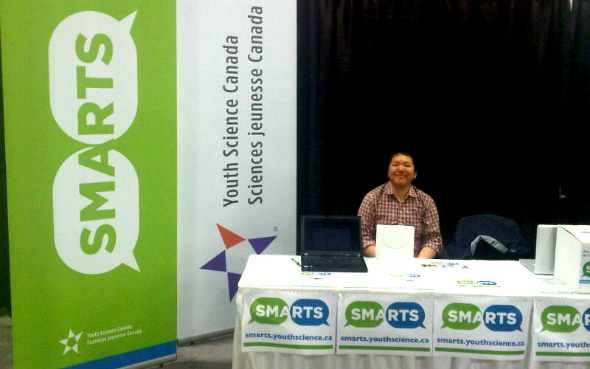5 Tips for a Successful Elevator Pitch
Categories: Personal Development

This past Monday and this morning, I was at the 2011 Canada-Wide Science Fair encouraging this year’s participants to try out the brand new SMARTS website. (When I started SMARTS in 2004, it was a plain website with information on a couple of science, technology, engineering and mathematics (STEM) opportunities myself and a few peers has been to. Over the next several years, we became a part of Youth Science Canada and grew into a network of over 200 schools and student volunteers. This week, we launched SMARTS 2.0 – an online community to connect and support young Canadians interested in science)
We had a display booth in the science fair exhibit hall, and our goal was to provide demos to the science fair participants walking around and encourage them to join. While I didn’t start with a particular spiel, I had a well-refined elevator pitch about SMARTS by the end. For those of you unfamiliar, an elevator pitch is basically a very brief summary that you present to people to capture interest when you don’t have much time.
At some point or another, all of us need to be able to deliver an elevator pitch, or at the very least, be able to describe something in as few words as possible, but still be highly valuable in content. Maybe you are marketing a product to a potential customer. Perhaps you run into a legendary researcher in your field and you only have a few seconds to share your idea. Or maybe you are trying to convince people to donate to a cause you are fighting so hard for.
Based on my experiences, I’d like to share with you 5 thing I’ve learned about making a successful elevator pitch.
1. Introduce yourself – create a connection
You would think this is obvious, but it actually doesn’t happen enough even though it only takes a few seconds. “Hi I’m Josh” *extend your hand for a shake*. That’s all it takes, but connecting with your audience is powerful, it attaches a human presence to your idea. It brings you and your audience onto the same plane. It’s no longer a stranger marketing a product, it is Josh, this personable individual who is sharing an idea with you.
It’s even better if you can state a clear connection between the two of you. For example, when I introduced myself to the Canada-Wide Science Fair (CWSF) finalists, I said, “Hi, I’m Josh, I’m a CWSF alumni from about 5 years ago. What’s your name?” In a matter of a few seconds, I went from this unnamed stranger to Josh, a student who had been in your exact position 5 years ago.
2. Keep it brief
Again, this should be obvious – elevator pitches are based on the idea of giving an idea during a short 30 sec to 1 min elevator ride. But unless you prepare a short, concise speech, it’s so easy to go over time. Keep it to 1 minute or less if you can. I usually tell people “can I have a minute of your time?”. I don’t want to lie!
3. Describe your idea in one sentence before moving on to any details
Before you throw out any details, you should be able to give the main idea of your message in one sentence. Trust me, you can. You just need to find a way. For me, it was: “SMARTS is an online community for young people interested in science”.
4. Tailor your message to your audience
Very often your idea is big or complex and is useful to many kinds of people. You need to tailor your elevator pitch to that exact person you are talking to. Only mention things about your idea that are relevant to that person. You have less than a minute, don’t forget that.
Think about what drives the specific population you are pitching to. What would be incentives for them? What would be disincentives? Drivers? Turn offs? And tailor your message appropriately.
When I was speaking to a student, I would say “SMARTS is here to help you guys stay connected with each other after the science fair.”
If a teacher dropped by, I would say “SMARTS is a great way for your students to learn about new opportunities beyond science fairs”.
Both of those statements are true, but I am sharing the most relevant aspects of SMARTS with the most relevant audience. The biggest thing on the minds of science fair participants this week is how awesome a time they had, and how much they’re going to miss the friends they made. While they will likely be interested in learning about new opportunities some time or another, that’s not the biggest thing on their mind right now.
5. Thank the person at the end, whether or not they are convinced
Always thank the person, whether or not you are able to convert them into a believer in your idea. Often, people need time to think, and will come around later. Stay positive, be nice, thank them for their time. If you don’t, you really might have lost a potential supporter you never realized you had.